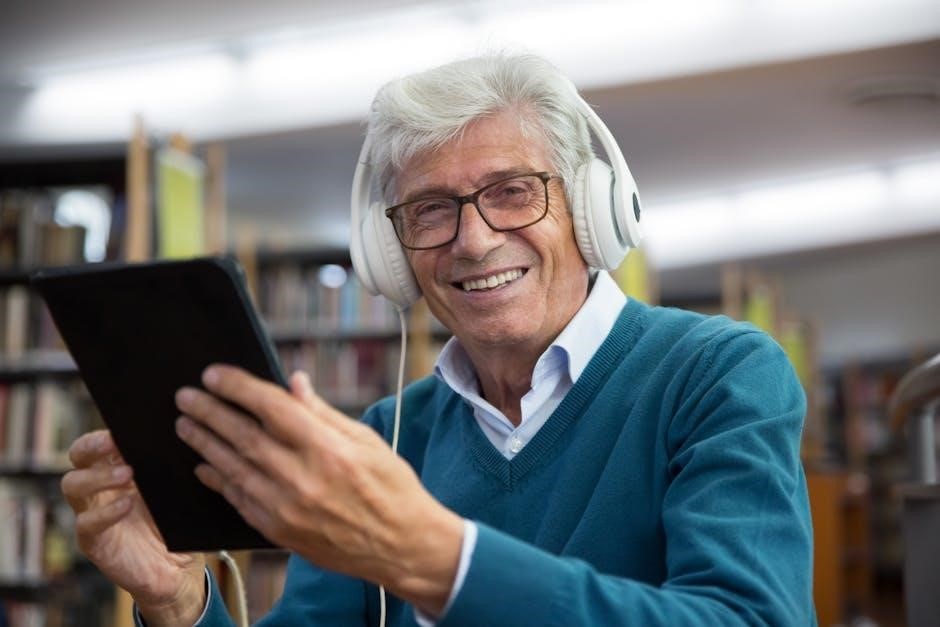This book provides practical strategies for integrating technology and media into classrooms, focusing on the ASSURE lesson plan model. It equips educators to enhance teaching and learning through various technologies, addressing 21st-century educational needs with a strong emphasis on ethical media use and learning theories.
Overview of the Book and Its Authors
Instructional Technology and Media for Learning is authored by Sharon E. Smaldino, Deborah L. Lowther, and Clif Mims. Smaldino, a renowned expert in educational technology, has contributed significantly to the field, while Lowther and Mims bring extensive experience in integrating technology into classrooms. Published by Pearson, the book is now in its 12th edition, reflecting its enduring relevance. It serves as a comprehensive guide for educators, offering practical strategies for incorporating technology and media into teaching practices. The authors emphasize ethical media use, copyright concerns, and the application of learning theories to create effective instructional designs.
The Evolution of Instructional Technology in Education
Instructional technology has evolved significantly, from traditional tools like films and projectors to modern digital solutions. The integration of computers, the internet, and multimedia revolutionized education, enabling interactive and engaging learning experiences. Recent advancements in Web 2.0 tools, distance learning platforms, and blended learning models have further transformed teaching practices. Smaldino’s work highlights this progression, emphasizing the role of technology in meeting the needs of diverse learners. The evolution underscores the importance of adapting educational strategies to leverage emerging technologies effectively, ensuring relevance in an ever-changing educational landscape.
The ASSURE Lesson Plan Model
The ASSURE model is a systematic approach to designing effective lessons, ensuring technology and media are purposefully integrated to enhance teaching and learning experiences for all students.
Understanding the ASSURE Framework
The ASSURE framework is a structured approach to lesson planning, emphasizing the integration of technology and media. It stands for Analyze learners and context, Set clear objectives, Select appropriate methods, Utilize media effectively, Require learner participation, and Evaluate outcomes. This model ensures that technology and media are purposefully aligned with instructional goals, fostering engaging and effective learning experiences while addressing diverse student needs and promoting achievement.
Applying the ASSURE Model in Classroom Settings
The ASSURE model offers educators a systematic approach to integrating technology and media effectively. By analyzing learner needs and setting clear objectives, teachers can select appropriate media and technologies to support instruction. Utilizing tools like multimedia presentations or interactive software ensures engagement. Requiring active learner participation enhances understanding. Finally, evaluating both learner outcomes and the effectiveness of the technology ensures alignment with instructional goals. This model provides flexibility, enabling teachers to adapt strategies across diverse classroom settings while maintaining focus on enhancing student learning experiences through purposeful technology integration.

Key Features of Instructional Technology and Media for Learning
The book provides practical strategies for integrating technology and media, preparing educators to use tools like multimedia and internet resources effectively while addressing copyright concerns.
Integrating Multimedia and Internet Resources
The book emphasizes the integration of multimedia and internet resources to enhance teaching and learning. It provides practical examples of how educators can effectively incorporate multimedia elements, such as videos, animations, and interactive simulations, to make lessons more engaging. Additionally, it covers the use of internet resources, including Web 2.0 tools, to foster collaboration and active learning. The text also addresses copyright concerns, offering guidance on ethical media use and suggesting free or low-cost resources. By leveraging these tools, educators can create dynamic, student-centered learning environments that cater to diverse learning styles and needs.
Addressing Copyright Concerns and Ethical Use of Media
The text highlights the importance of understanding copyright laws and ethical media use in education. It provides clear guidelines for educators on how to legally incorporate media resources into their teaching practices. Topics include fair use provisions, public domain materials, and Creative Commons licensing. The book also emphasizes the ethical implications of using digital content, ensuring educators are well-informed to avoid copyright infringement. By adhering to these principles, teachers can responsibly integrate media while respecting intellectual property rights and promoting legal, ethical learning environments.

Learning Theories and Instructional Models
This section explores foundational learning theories, including Behaviorism, Cognitivism, and Constructivism, and their application in instructional design. It emphasizes how these theories support effective teaching and technology integration.
Behaviorism, Cognitivism, and Constructivism in Instructional Design
The book examines three core learning theories: Behaviorism, Cognitivism, and Constructivism. Behaviorism focuses on observable behaviors shaped by stimuli and responses, while Cognitivism emphasizes mental processes like memory and problem-solving. Constructivism highlights how learners construct knowledge through experiences. These theories guide instructional design by tailoring strategies to how students learn. Behaviorist approaches use reinforcement, Cognitivist methods focus on clear objectives, and Constructivist techniques encourage active participation. Understanding these theories helps educators align technology and media with effective teaching practices, ensuring engaging and meaningful learning experiences for diverse learners.
The Role of Social Learning Theory in Technology Integration
Social Learning Theory emphasizes observation, imitation, and modeling to acquire new behaviors. In technology integration, this theory suggests learners gain skills by observing peers and instructors using technology. The book highlights how educators can model effective technology use, fostering engagement and proficiency. By incorporating collaborative tools and multimedia, educators create environments where students actively participate and learn from one another. This approach aligns with the book’s focus on preparing educators to integrate technology seamlessly, ensuring learners develop essential skills for the digital age while maintaining meaningful interaction and knowledge construction.
Technology Integration Strategies for 21st Century Learners
Strategies include using computers, multimedia, and Web 2.0 tools to enhance learning, preparing educators to integrate technology effectively for 21st-century learners.
Using Computers, Multimedia, and Web 2;0 Tools Effectively
Smaldino’s text emphasizes the importance of leveraging computers, multimedia, and Web 2.0 tools to create engaging and interactive learning experiences. These technologies enhance student engagement and cater to diverse learning needs.
By integrating multimedia elements such as videos, animations, and simulations, educators can make complex concepts more accessible. Web 2.0 tools like blogs, wikis, and collaborative platforms foster creativity and teamwork, preparing learners for a digital future.
Implementing Distance Learning and Blended Learning Models
Smaldino’s text explores the integration of distance learning and blended learning models, emphasizing the use of technology to create flexible and accessible learning environments. Distance learning leverages digital tools to deliver instruction remotely, while blended learning combines traditional classroom methods with online resources.
Both models enhance engagement, accommodate diverse learning needs, and promote personalized instruction. By incorporating multimedia and internet-based tools, educators can create dynamic learning experiences that cater to 21st-century students, ensuring they are well-prepared for the demands of a rapidly evolving educational landscape.

Case Studies and Real-World Applications
The book features real-world examples of successful technology integration in K-12 and higher education settings, highlighting challenges, solutions, and measurable outcomes that enhance teaching and learning.
Success Stories in K-12 and Higher Education Settings
The book shares compelling success stories where educators effectively integrated technology and media to transform learning experiences. In K-12, teachers used multimedia tools to boost student engagement and achievement, while in higher education, flipped classrooms and online resources enhanced deep learning. These case studies demonstrate how the ASSURE model and strategic technology integration can address diverse learner needs and create meaningful educational outcomes.
Lessons Learned from Implementing Instructional Technology
Implementing instructional technology reveals key lessons, such as the importance of aligning technology with learning objectives and addressing copyright concerns. Educators must balance innovation with practicality, ensuring equitable access and fostering digital literacy. Professional development is crucial for effective technology integration, as is continuous evaluation of tools and methods. Challenges like technical glitches and resistance to change highlight the need for flexibility and adaptability. By learning from these experiences, educators can refine their strategies, creating more engaging and effective learning environments for all students.

Future Trends in Instructional Technology and Media
Future trends emphasize AI, VR, and AR integration, fostering personalized learning and dynamic interactions. Educators must adapt to these innovations to prepare learners for tomorrow’s challenges effectively.
Emerging Technologies and Their Impact on Education
Emerging technologies like AI, VR, and AR are revolutionizing education by enhancing engagement and personalization. These tools create immersive learning environments, making complex concepts more accessible. AI-driven adaptive learning systems tailor instruction to individual needs, while VR and AR provide hands-on experiences in virtual settings. Such technologies not only increase student engagement but also prepare learners for future challenges. Educators must embrace these innovations to deliver high-quality, interactive instruction that meets the demands of a rapidly evolving world. The integration of these technologies ensures education remains relevant and effective for future generations.
Preparing Educators for the Next Generation of Learners
Smaldino’s work emphasizes the importance of equipping educators with the skills to leverage technology and media effectively. By focusing on professional development and practical strategies, the book prepares teachers to adapt to evolving educational landscapes. It encourages the integration of innovative tools and methodologies, fostering a culture of continuous learning. Educators are empowered to create engaging, technology-rich environments that cater to diverse learning needs. This preparation ensures they can meet the demands of 21st-century learners, fostering academic success and lifelong learning skills in a rapidly changing world.